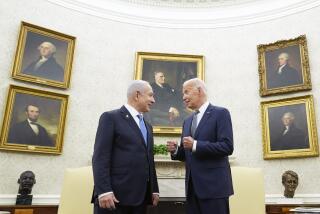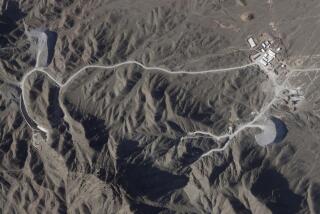U.N. Uncovers Iraqi Effort to Build H-Bomb
- Share via
UNITED NATIONS — Iraq operated a secret, ambitious program to build a hydrogen bomb, a parallel effort to its already disclosed, huge push to develop an atomic bomb, U.N. officials said Tuesday.
After briefing Security Council members, Hans Blix, director of the International Atomic Energy Agency, told reporters here that documents recovered by a 45-member U.N. inspection team, which was detained for three days in a Baghdad parking lot last month, revealed that Iraqi President Saddam Hussein’s scientists had produced a small quantity of lithium-6.
Lithium-6, he said, is the basic fusion element used in hydrogen bombs, which are many times more powerful than atomic bombs. The documents showed that Iraq had ambitious plans to produce about 220 pounds a year of the material.
Neither Blix nor David A. Kay, the American who headed the inspection team detained in Baghdad, would reveal how much lithium-6 is needed to produce a working thermonuclear weapon. But they said that the documents indicate that Iraq was engaged in a major effort.
“It is significant because it indicates the ambition of their weapons program,” Kay told reporters at a news conference. “We know from the documents that they had produced small amounts (of lithium-6) and they had an ambitious plan for producing a much larger amount, in the range of 100 kilograms a year.
“It tells you they were serious,” he said. “I don’t think they were experimenting. I think the Iraqi program in general was very sophisticated. It should not be underestimated. It was a very good program. . . . My guess is that the small amount they were able to produce was for pilot-testing the process. I was extremely surprised to find they were this much advanced on lithium-6.”
Kay said the documents show that Iraq’s scientists already had produced a small amount of lithium-6, although “we do not have exact knowledge of how much.”
Nuclear experts are scrutinizing thousands of pages of documents that Kay’s team seized Sept. 23-24 from a records depository in Baghdad and at the Iraqi Atomic Energy Commission.
Blix said analysis of the documents will take weeks. He noted that Iraq had failed to return some crucial papers--many of them believed to be progress reports--that the team had seized but which were lost when guards forced the inspectors to relinquish them. Kay said the IAEA is preparing a roster of the missing documents, whose cover pages the inspectors had photocopied.
The discovery that Iraqi scientists were engaged in lithium technology clearly added a new, ominous dimension to Hussein’s weapons program. U.N. inspectors last week disclosed in Vienna that Iraq was within a year or 18 months of building an atomic bomb and a missile system to deliver it when the Gulf War began.
U.S. military officials have insisted that Iraq no longer poses a nuclear threat, because most of its devices and facilities were destroyed by the allied bombing campaign.
But the United States and U.N. officials have agreed that the world may never know the extent of Iraq’s efforts to develop weapons of mass destruction, particularly because of Baghdad’s attempts to hide various aspects of its programs.
To ensure that it never realizes its nuclear ambitions, the United States and the U.N. have insisted that Iraq must be subject to a sweeping inspections program. The discovery of hydrogen bomb research undoubtedly will increase the urgency for the United Nations to root out and eliminate Iraq’s weapons effort, as required under terms of the Gulf War cease-fire.
Kay said Tuesday that a hydrogen bomb built by Iraq could possess 100 times the power of a conventional atomic bomb. He said initial inspection of documents showed that the mechanics of Iraq’s thermonuclear program appeared to be “home-grown.”
A major task facing the analysts will be to try to determine how much lithium-6 Iraq has already produced. Kay said the most recent document mentioning the key substance was dated January, 1991.
When told of the Iraqi program, other analysts were stunned.
“The ambition and scope of Iraq’s program is amazing,” said a key U.S. nuclear scientist. “We have said over and over it is comparable to the Manhattan Project.” The Manhattan Project produced the American atomic bombs that were dropped on Japan at the end of World War II.
“Now we know they were trying to get a more sophisticated bomb. They were not taking baby steps. They wanted the whole nine yards,” said Leonard Spector, an expert on nuclear proliferation and an official at the Carnegie Endowment for International Peace.
Blix said the U.N. nuclear inspectors--the sixth team to enter Iraq--have recovered thousands of pages of documents. A special team of translators, as well as nuclear experts, is poring over the papers. He said he expects the team to issue a number of progress reports to the Security Council as the pages are analyzed.
Destroying the Iraqi ‘Super Guns’
Iraq planned to build five “super guns,” with which Baghdad could have attacked neighboring capitals, a U.N. official said Tuesday after watching Iraqis dismember two of the guns. Smaller version, at right, is about 165 feet long with a bore of 350 millimeters (13.8 inches). It was test-fired at a range of 125-160 miles. On Monday, parts for a larger, 495-foot-long 1,000-millimeter (39.4 inches) cannon with a 600-mile range were cut up with torches at a site south of Baghdad, a U.N. official said.
Map illustrates 160-mile range of small “super gun” (A). Large gun (B) would fire 600 miles.
More to Read
Sign up for Essential California
The most important California stories and recommendations in your inbox every morning.
You may occasionally receive promotional content from the Los Angeles Times.













